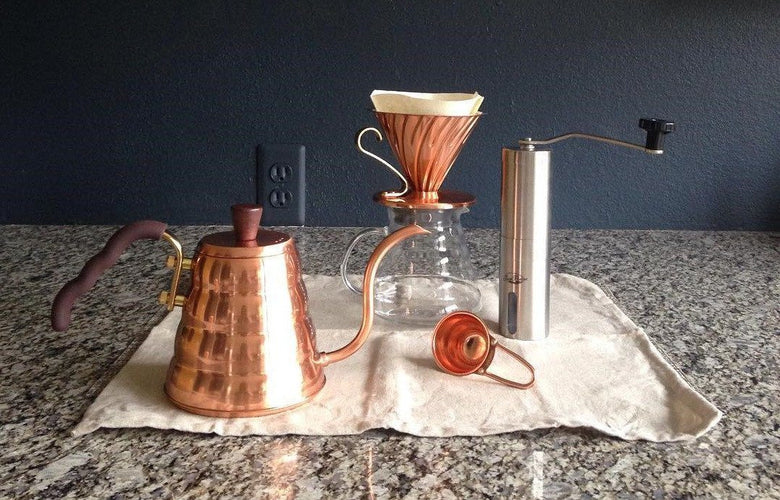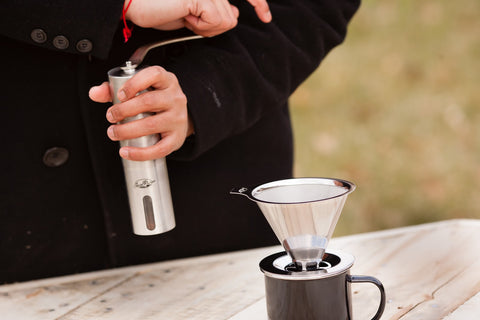I remember the first time I tasted specialty coffee. It had a crisp apple-like acidity, a rich, heavy body, and a refreshing sweetness. I was hooked instantly and wanted to figure out what equipment I needed to make it at home.
The next few weeks were filled with research and stress as I tried to make sense of a big mess of data on coffee brewers and other tools. There was so much to read that I nearly gave up.
I want to help you avoid that stressful stage.
There are thousands of creative and unique specialty coffee products out there, but to get started with specialty coffee at home, you only need a few key pieces of equipment. Let’s talk about the essentials so you can get to brewing!
A Manual Coffee Brewer
Specialty coffee shops litter the globe, and more are opening every day. If you visit enough of them, you’ll notice a common pattern: manual coffee brewing methods are favored over auto drip coffee pots.
There are a couple of reasons that french presses, pour over cones, and the Aeropress have taken the specialty coffee world by storm.
- They brew stellar coffee
- They put you right in the action
- They offer far more control and variation than drip pots
Trust me; specialty coffee baristas aren’t crazy. Manual methods have a clear edge over regular drip pots in terms of simplicity, control, and quality. They are designed to function simply and effectively, unlike electric drip pots, which use poor technique and low-quality materials.
Read: Aeropress VS French Press
When you break down the steps to using an auto drip pot, making a cup or two of french press coffee requires no extra effort. Even if it did, the taste would make it far worth it.
Most manual brewers won’t run you more than $30, They’re simple to use, and will leave you incredibly satisfied. If you’d like to take a look at a couple, we suggest getting started with a french press or pour over cone.
A Manual Coffee Grinder
I cannot over-stress the significance of grinding your coffee just before brewing. Though you need a brewer to make balanced and rich coffee, your brewer won’t do much good if your coffee is stale and lifeless.
Contrary to what some coffee roasters would like you to believe, roasted coffee has only two or three weeks of peak freshness. During these first few weeks, the coffee tastes vivid, bright with a refreshing acidity, ripe with fresh flavor, and sweet. Once the coffee comes into contact with oxygen, it begins to decay. Rich flavors die off and form a soupy, muddy flavor that’s bitter and unpleasant.
Pre-ground coffee has about 20 minutes before it rapidly decays to a poor flavor. This is why it’s so important to wait to grind your coffee until you’re ready to brew it! A reliable burr coffee grinder is a 100% essential tool for brewing delicious, rich, and balanced coffee at home.
Beyond freshness, home grinders allow you to grind coffee to different particle sizes, which enables you to use a variety of coffee makers since they all thrive with a slightly different grind size.
Read More: Why A Grinder Is The Best Coffee Gear
If you want to be able to use any coffee maker in the world, you must have your grinder.
A Couple Semi-Essentials
While the upper two pieces of equipment are non-negotiable when it comes to brewing the best coffee you can, these below are only highly recommended. Owning both of these will take your arsenal to a level that can accomplish almost anything coffee-wise, but some successful coffee enthusiasts get by without them.
If you have to choose one, I suggest you go with the scale.
A Coffee Scale
I thought the idea of using a kitchen scale to weigh coffee was a ridiculous waste of time at first. That quickly changed, and I became a scale owner early into my specialty coffee days.
The amount of coffee and water you use can affect your final cup in a dramatic way. We like to say that the ideal coffee to water ratio zone exists between 1g:15g and 1:18 (coffee: water). This range produces a balanced extraction at a strength that most people love. Sure, you are free to go outside those bounds, but you’ll probably have to sacrifice balance or strength (thus, overall quality).
A coffee scale enables you to brew coffee consistently and confidently. Without a scale, you’ll be left guessing, which won’t help improve your coffee brewing routine.
If you want to be consistently satisfied by your coffee, a gram scale is a great investment. It doesn’t take much longer to brew your coffee, but the reward is precision, consistency, and a higher quality mug.
Read: How To: The Golden Ratio in Coffee Brewing
A Pour Over Kettle
If you’re using a pour over coffee brewer, the way that you pour the water can affect your brewing quite a bit.
Your average kettle with a big spout makes a slow, consistent pour difficult to accomplish. If you don’t have a controlled pour, it’s easy to brew unbalanced coffee by not saturating all of the grounds evenly.
A pour over kettle with a specialized gooseneck, on the other hand, is designed to enable you to pour in a slow, controlled manner. With a high level of precision, you’ll be able to saturate and extract all the grounds evenly and perfect your pouring technique.
Once again, if you’re interested in brewing the best coffee you can with a pour over brewer, a gooseneck kettle is a strong investment.
We've created some of our own coffee products over the last few years to empower people to brew better coffee. I invite you to check out our JavaPresse Manual Burr Coffee Grinder.




